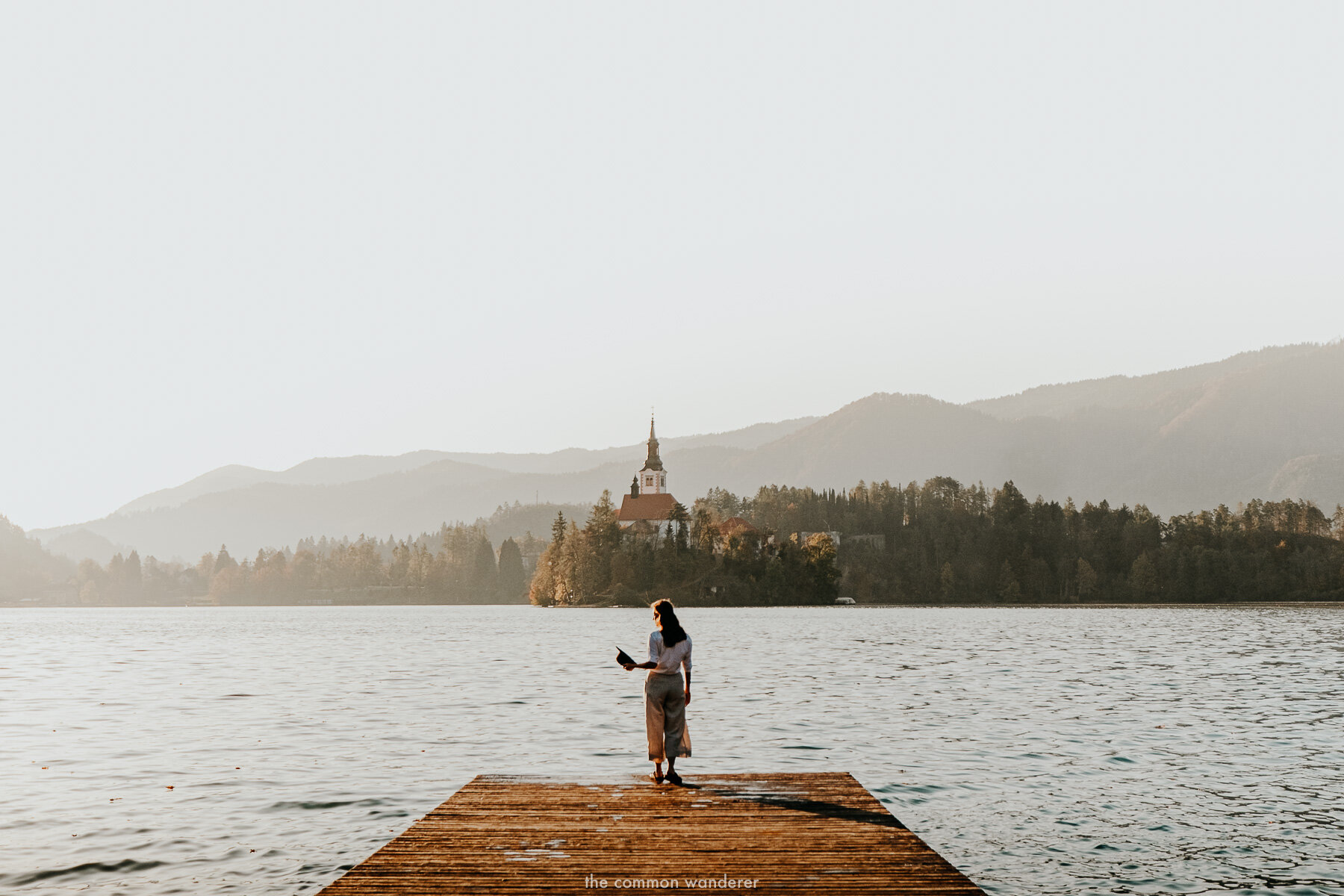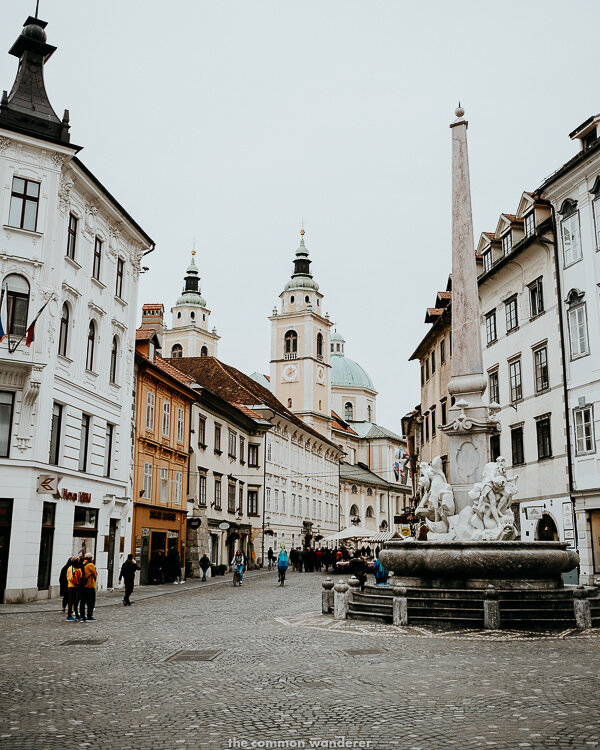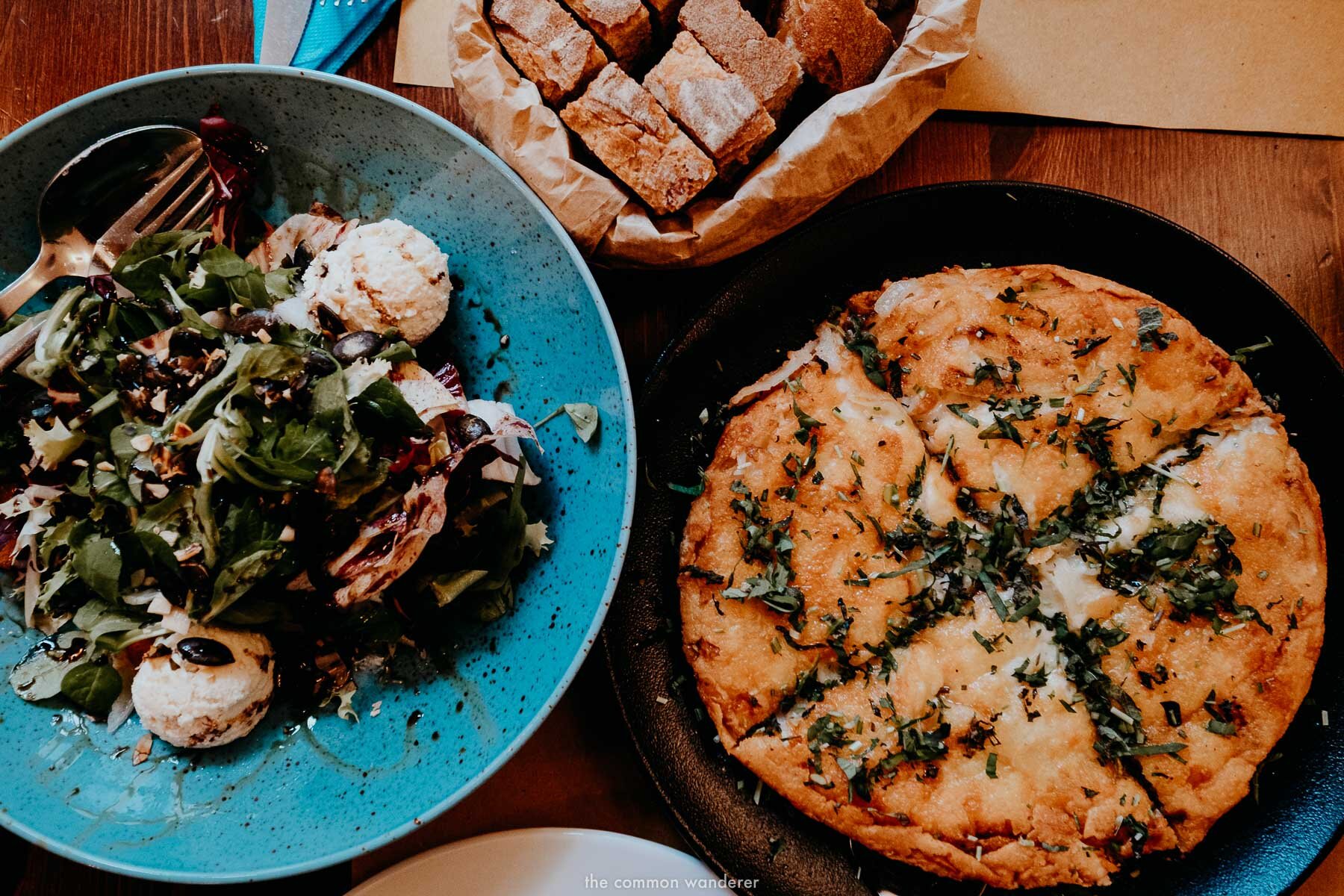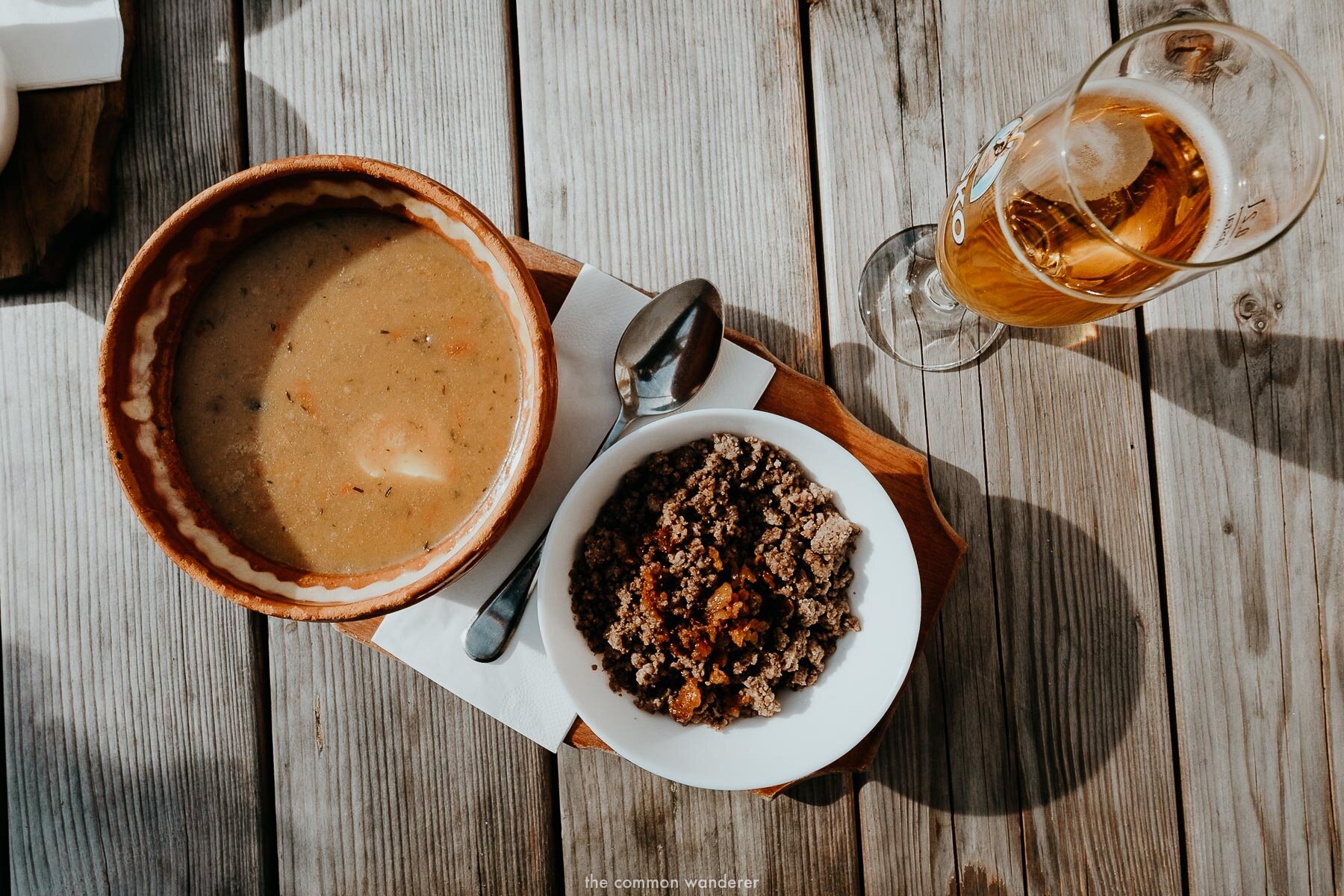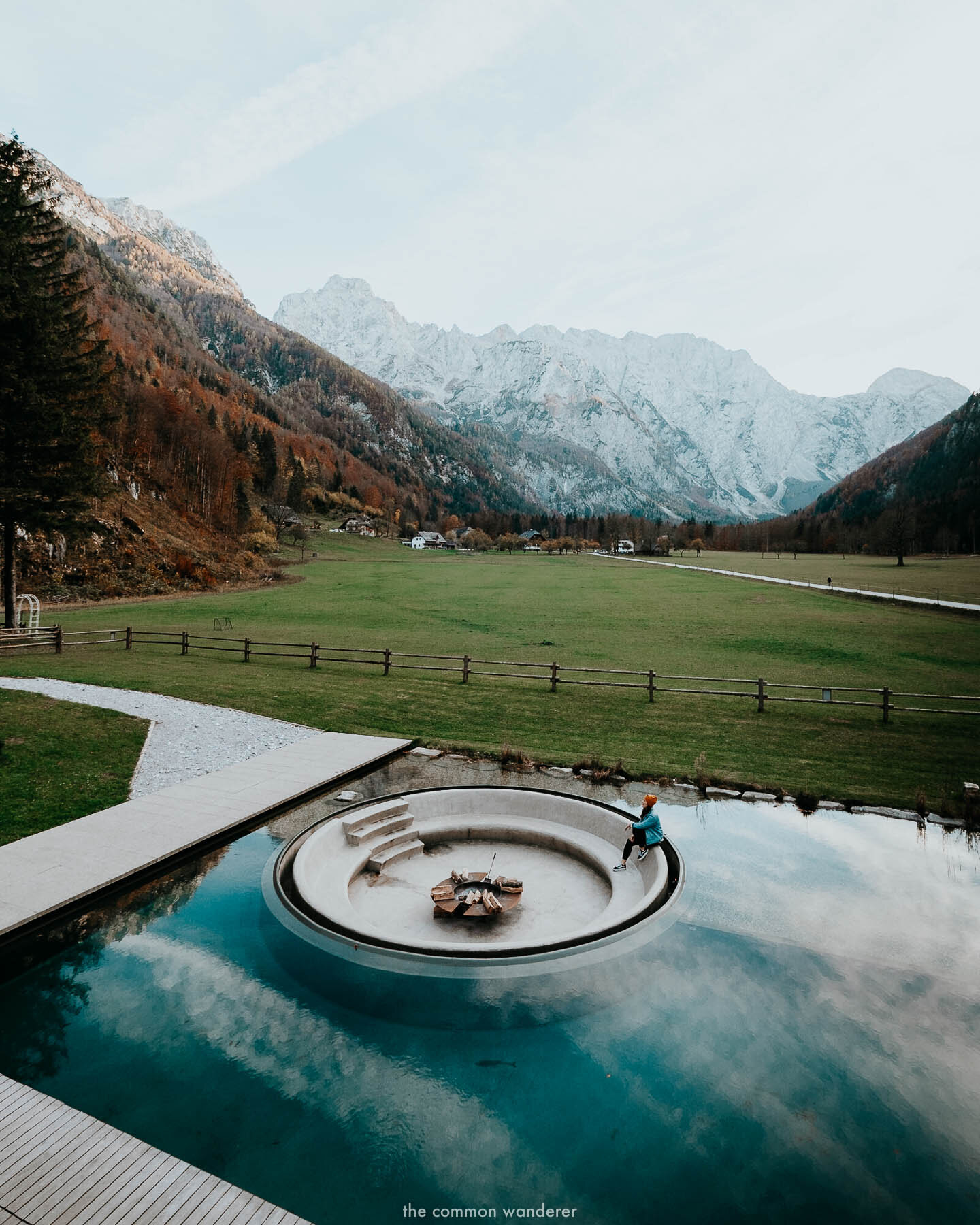Our Slovenia Travel Guide: What to See, Know and Do
Ready to enjoy one of Europe’s best countries? Our Slovenia travel guide gives you the low down on everything you need to know before visiting, including what to see, eat and do, essential travel information, and how to get around.
We’ve now taken five trips to Slovenia and we’re still enamoured with this bite-sized country.
How could we not be - Slovenia is so damn perfect.
Where else in the world can you find such a huge amount of things to see and do in such a small area? From the peaks of the Julian Alps to the Mediterranean coast; the quaint old town streets of Ljubljana to the emerald waters of the Soča; and let’s not forget the alpine lakes of Bled, Bohinj and Jasna - Slovenia packs a huge punch.
That’s not forgetting the burgeoning culinary scene, which melds the best of fresh Mediterranean cuisine and hearty Alpine fare, and a wine culture which rivals that of Italy or Croatia.
What’s more, for all types of travellers to Europe, it’s affordable, easy to get to, and super easy to get around.
We’ve said it many times before, but we really believe Slovenia is the best country in Europe, pound for pound. To make the most of your stay, we’ve put together this Slovenia travel guide, full of all the essential information you need to have an incredible stay in the country.
We hope you enjoy this country as much as we do.
SLOVENIA TRAVEL GUIDE | WHAT TO SEE, KNOW AND DO
SLOVENIA TRAVEL GUIDE | THE SHORT OF IT
Slovenia Highlights | Ljubljana, Lake Bled & Bohinj, hiking in the Triglav Mountains, Soča Valley
How long should you spend in Slovenia? | 3 - 7 days
Best time to visit Slovenia? | Spring (May - June) or Autumn/Fall (October - November)
How to get around Slovenia? | Slovenia is perfect for a road trip
Capital | Ljubljana
Population | 2 million
Currency | Euro
Language | Slovenian
Visa | Schengen zone
SLOVENIA TRAVEL GUIDE | THE ESSENTIALS
FIRSTLY, WHERE IS SLOVENIA?
Tiny Slovenia is located in central Europe, nestled amongst Italy to the west, Austria to the north, Hungary to the east, and Croatia to the south west, with a small but important coastline on the Adriatic.
Slovenia covers 20,273 square kilometres (7,827 sq mi) and has a population of just over 2 million, making it one of the smallest countries within the European Union.
For a country so small, it has a huge range of geographical diversity, with alpine peaks in the north and west, and coastal plains in the south.
AND THE BEST TIME TO VISIT SLOVENIA IS...
Well that really depends on what you’re after!
We’ve visited Slovenia in spring, summer and autumn and have found all of these seasons to be highly agreeable.
Either shoulder season of Spring or Autumn is the perfect time to visit Slovenia.
In spring (May - June) the meadows are covered in wildflowers and the mountain peaks in snow, while the weather is comfortable, if not a little cool at times.
We took our road trip through Slovenia in autumn (September to early November), which we found perfect.
Over this period, the fall colours were breathtaking, the crowds thin, and the accommodation slightly cheaper.
Summer (July - August ) is obviously the busiest time to visit, so we’d avoid travelling over this time at all costs. Slovenia’s best things to do can be overrun, the roads busy, and the summer temperatures almost too warm for outdoor activities.
VISA REQUIREMENTS FOR SLOVENIA
Like most of Europe, Slovenia is a member state of the European Union and part of the Schengen agreement, which allows free movement between countries. This means the country is super easy to visit, and there are no border controls between neighbouring countries like Italy and Austria.
If you’re an EU citizen, you’ve got no issues visiting the country.
If you’re from outside the EU, your trip to Slovenia will count towards your 90 day Schengen visa, or visa-free entry for selected countries including Australia, USA and Canada.
If you’re unsure of your visa requirements, check out this website before you travel.
WHAT TO SEE IN SLOVENIA | THE GOOD STUFF
SLOVENIA WILL BLOW YOUR MIND
You’ve been warned…
Slovenia is a seriously beautiful country, and we’re constantly shocked that so much history, culture and attractions can exist in such a small country.
From the towering snow-capped peaks of the north, to the shimmering (albeit, small) Mediterranean coastline, the bright turquoise rivers to the stunning blue lakes, Slovenia is a nature lovers paradise.
The adventure activities are vast and amazing, including rafting, kayaking, hiking and biking.
In addition to the vast natural beauty, Slovenia is also home to the picturesque capital of Ljubljana, which has one of the most beautiful old towns we’ve ever seen, and a myriad of quaint towns where time has frozen still, such as Kobarid and Kanal ob Soci.
Oh, and did we mention the food...? We’ll talk about that later!
RELATED | 14 amazing things to see and do in Slovenia
LJUBLJANA IS A FAIRYTALE…
Orange fairy-lights twinkle in the crisp autumn evening. The smell of roasted chestnuts wafts through the air. Notes and melodies from a busker bring a tear to our eye.
In front of us, the beautiful Tromostovje (the three bridges) is artfully lit up, while in the distance, the pastel hues of art nouveau buildings compliment the pastel skies.
“This place is a fairytale”, says Mim, jaw firmly planted on the floor.
For years, I’d told her how Ljubljana was my favourite city in all of Europe. “It’s stunning, and fun, and cheap” I’d exclaim. And while she happily nodded along, she didn’t know. She had to see it with her own eyes.
And now she was.
Ljubljana isn’t big, nor admittedly, is it that appealing outside the old town - but the old town is easily one of Europe’s most beautiful. It’s full of Art Nouveau and Baroque architecture, beautiful bridges, endless cobblestone streets, and leafy gardens.
For us, it’s got the right amount of hipster cool and old world charm. There are artsy cafes and artisanal coffee shops, nestled amongst ancient churches and cobblestone streets. There are historic museums and galleries, and liberal communes and street art.
Not only that, it’s an eco-conscious traveller’s paradise; Ljubljana was voted "Green Capital of Europe” in 2016, because of its many green schemes to promote a better life for its citizens.
This makes the city wonderfully accessible for tourists, be it by communal bikes or by foot. A fairytale alright!
...WITH LOTS TO SEE AND DO
Beyond the beauty, there’s a huge amount to see and do in the city, especially for those on a city break. In fact, it’s the perfect city to visit on a weekend as everything is in such close proximity.
The centre point for all things Ljubljana is Prešeren Square, developed at the point of a medieval crossroad into the former walled city. It’s surrounded by the famous pink facade of the Franciscan Church, the white-washed Triple Bridge which extends over the Ljubljanica River, and the pedestrianised old town, all which lead to the attractive town square and Robba fountain.
From here it’s possible to explore the 16th century Ljubljana Castle, walk the narrow streets of the old town, have a long and lazy coffee break, buy gourmet local produce at the central markets, take in the leafy riverside, or jump inside one of the many bars and restaurants.
Below is quick overview of some of our favourite things to do in Ljubljana (a more comprehensive post coming soon, promise!):
Ljubljana Castle | For the best views in town, jump aboard the funicular, or walk through the leafy pathways to the the castle. Stay for sunset and watch the city light up
Ljubljana Old Town | Get up early to explore the old town streets and alleyways, sans tourists. Gornji Trg was our favourite street, full of pastel colours and endless wonder
Tivoli Gardens | Stroll the chestnut-tree-lined pathways of Ljubljana’s largest, most beautiful park, the 1,260-acre Park Tivoli
Petkovšek Embankment | Sit by the banks of the Ljubljanica River enjoying a beverage or two in the summer sun
Ljubljana Central Market | Ljubljana’s farmers market is full of local produce such as Slovenian honey, and our favourite, pumpkin oil (this will change your life!)
Eat at Julija | Our favourite restaurant in Ljubljana by far - try the cheese dumplings (thank us later!), and finish the meal off with apple strudel and ice cream
Stow Coffee | Ljubljana has a burgeoning coffee scene, with Stow being the best coffee in town. Head there for a pick-me-up, and one of their delicious cakes
TRAVEL TIP | Grab a Ljubljana tourist card for either 24, 48, or 72 hours for access to most major attractions
SLOVENIA IS PARADISE FOR OUTDOOR ENTHUSIASTS
Slovenia is home to a burgeoning adventure sports and outdoor scene, with Bled and Bovec the epicentre of wonderful activities.
There’s a myriad of adventure activities on offer, including rafting and kayaking along the Soča, zip-lining, climbing or cycling.
For hikers, there are endless trails through the Julian Alps, including the recently finished Juliana hiking trail, a 270km trail set across 16 stages, ranging between 17km - 25km per day.
We’ve written all about the best things to do in Slovenia, which you can read here.
RELATED | 14 amazing things to see and do in Slovenia
SLOVENIA FOOD | WHAT, AND WHERE TO EAT
SLOVENIA HAS A BURGEONING CULINARY SCENE
Slovenian cuisine is a glorious mix of local ingredients, melded with Italian, German and Balkan elements to form delicious, hearty dishes.
The burgeoning food scene is led by Ana Roš, who has almost single-handedly put Slovenia on the food map via her restaurant, Hiša Franko, located in the stunning Soča Valley.
Farm-to-table is now all the rage, and with good reason - the produce in Slovenia is incredibly good, and most dishes use a mix of locally sourced seasonal produce along with meats or fish.
Some of the best restaurants in Slovenia include:
HIŠA FRANKO | KOBARID
Among the towering Slovenia Alps and the fertile Soča Valley isn’t where you’d expect to find one of the greatest restaurants in the world, yet this is where you’ll find Hiša Franko, rated among the 50 Best Restaurants in the World in 2018).
Serving a tasting menu filled with artistically created ‘bites’, the two + hour dining experience is one of the books.
As Ana says, “if you really want to experience the real expression of my cuisine, go with the flow and let us serve you our food, no restrictions, no limitations.”
While we weren’t fortunate enough to secure a booking at Hiša Franko during our spontaneous trip to Slovenia, we are inspired to visit in future, having also been inspired by Ana’s episode on Netflix’s incredible Chef’s Table.
HIŠA POLONKA | KOBARID
Set behind the blue facade in the old town of Kobarid is Hiša Polonka, owned by Slovenia’s best chef, Ana Roš, and her husband Valter. The tavern offers local cuisine based on family recipes at reasonable prices (mains start at €10).
We recommend the delicious vegetable soup, super moreish shepherds potato & cheese pie (Frico), a seasonal salad and a delicious local dessert, and left thoroughly satisfied.
JULIJA | LJUBLJANA
Julija was our favourite restaurant in Ljubljana by far.
Located off the cobblestoned streets of Ljubljana’s old town, Julija serves a range of delicious dishes with a Slovenian & Italian flavours. Our favourite dish was without question was the cheese dumplings, served with a rich mushroom sauce - a melt in your mouth meal.
For more incredible places to try in Slovenia, check out this article which includes recommendations from Ana Roš.
SOME ESSENTIAL SLOVENIAN DISHES/PRODUCE YOU SHOULD TRY
Here are a few of our favourite Slovenian dishes that we’ve tried and enjoyed over the years.
Dumplings/štruklji | Sweet or savoury, dumplings come in all types in Slovenia. Our favourites are the cheese dumplings, served with a mushroom sauce
Frico (potato & cheese pie) | Traditional farmer’s pie made of potato and cheese - basically the greatest pie that’s ever been made - crispy cheese on the outside, cheese and potato on the inside
Mushroom soup | Mushrooms are in abundance in Slovenia, and a fresh mushroom soup is beyond delicious.
Pumpkin seed oil | Um, this might be the greatest thing we’ve ever tried! Used to dress everything from salads to ice cream, pumpkin seed oil is a taste sensation
Slovenian honey | Slovenians love their honey - there are over 10,000 beekeepers in the country, which for a population of 2 million, is astounding. It makes sense - Slovenian honey is beautiful, so don’t forget to try/buy some
SLOVENIA TRAVEL GUIDE | HOW TO GET TO, FROM AND AROUND
HOW TO GET TO SLOVENIA
Given its proximity to the centre of Europe, Slovenia is super-well connected to its neighbouring countries.
We’ve caught both the bus and train to the country, and recommend this environmentally friendly option for anyone travelling from mainland Europe.
For us, Flixbus was a great option, which got us from Budapest to Ljubljana for €25, and we were able to carbon offset the journey.
BOOK | Check out Flixbus for cheap travel through Europe.
Slovenia is connected to many European countries via the rail network, including Hungary, Croatia and Austria. Trains to neighbouring Italy go through Austria.
For those coming from further afar, major European and UK carriers have flights connecting with Ljubljana airport, including budget carriers such as Easyjet and Wizzair.
Ljubljana airport is about 30min from town, and can be accessed by public bus 28, which services the route between Ljubljana bus station (next to Ljuljana train station), and the airport (45mins - €4).
Alternatively, jump in a taxi or shared van for €10-15.
SLOVENIA IS TINY… PERFECT FOR A ROAD TRIP
If you didn’t already know, Slovenia is small - for equivalency, it’s 12 times smaller than the UK, or less than 10% of the UK’s landmass (for our Aussie friends, Slovenia is 0.26% the size of Australia!).
In other words, it’s super easy to get around, and we think it’s perfect for a road trip.
BOOK | Search for car rental options in Ljubljana here
The freedom a car affords means you can discover all of Slovenia’s best things to do, and get some off the beaten track destinations, such as the Logar Valley, Bohinj, Kranjska Gora, and the Mangart Saddle without any issues, as well as.
For those wanting to do a roadie, our road trip guide can be found here, which has all the information you’ll need to plan your own incredible road trip.
RELATED | Our Slovenia road trip guide
...BUT IT’S EASY TO GET AROUND BY PUBLIC TRANSPORT
Another benefit to Slovenia being so small is that it can be very easy to get around by public transport, especially when the network is efficient, as Slovenia’s is.
All the major tourism destinations and attractions are easily accessible by public transport, and we’ve outlined more on Slovenia’s public transport options below:
BUS
Travel via bus is the next best alternative, as it services a wide range of destinations in Slovenia.
Major towns, such as Ljubljana, Maribor and Koper are serviced by large bus stations where tickets may be booked in advance. For smaller services, tickets must be purchased on board.
In the summer, connections are improved, and Ljubljana is serviced with almost all of Slovenia’s towns and cities, including the Adriatic coast.
We’ve only ever caught the bus network on the popular Ljubljana and Bled route, which was extremely easy to navigate and ran regularly, which is important for those who just want to see the main attractions. Other popular day-trips that can be done on public transport from Ljubljana include Postojna Cave, Predjama Castle, Velika Planina, Piran, and much more.
To check bus routes and timetables, click here.
TRAIN
Surprisingly for a country so small, Slovenia is serviced by an efficient rail network.
There is a range of services, including slow (LP) and Intercity (IC) trains, as well as the faster Inter City trains which service the Ljubljana - Maribor route. Eurail and InterRail passes are valid on Slovenian railways.
To check train routes and timetables, click here.
OUR 7 DAY SLOVENIA ITINERARY
If we’re honest, 7 days in Slovenia is not enough (but how long is?!). That being said, here’s a condensed version of our 9-day Slovenia itinerary which encompasses the best of the country.
LJUBLJANA | 2 Nights
See the best of Ljubljana over two nights. Walk the old town streets, exploring Ljulbjana Castle, take in the markets, and picnic in the Tivoli Gardens.
BLED | 2 nights
Bled is worth way more than one night, so stay two and admire the incredible natural scenery. Watch sunrise over Lake Bled, cycle to and explore nearby Vintgar Gorge, hike in and around beautiful Lake Bohinj, and watch sunset from Bled Castle. Oh, and don’t forget to eat a Bled cake!
RELATED | Our Lake Bled guide (+2-day itinerary)
KRANJSKA GORA | 1 night
An underrated pocket in the north-west of the country. Visit the beautiful Zelenci Nature Reserve, watch sunrise over Lake Jasna, drive the Vrsic Pass, and hike into the limestone peaks of the Julian Alps.
SOČA VALLEY | 2 nights
The Soča valley is all about the outdoors, and exploring this part of Slovenia requires a few nights. Raft/Kayak down the Soča, watch sunset from the Mangart Saddle, hike into the towering Triglav mountains, eat amazing Slovenian fare at Hisa Franko/Hisa Polonka, and generally just enjoy one of Europe’s most incredible natural environments.
TRAVEL IN SLOVENIA | MONEY MATTERS
SLOVENIA USES THE EURO
As Slovenia is in the EU, it uses the Euro currency. Which is brilliant, if you’re travelling through other Euro-countries as there is no need to change your currency.
The check the latest exchange rate, click here.
WHAT DO THINGS COST IN SLOVENIA?
We didn’t expect it, but during our autumn road-trip through the country, we realised Slovenia is kinda expensive.
That’s not to say it’s unaffordable, however accommodation, food, parking and tours are at least can be quite a bit more expensive than neighbouring countries in the EU (Hungary, parts of Italy, Croatia, Greece etc.). There’s also a tourist tax to pay at most destinations, which you’ll need to factor into your Slovenia travel budget.
For those travelling on the cheap (like us), we’d suggest a daily budget of €50 - €125 per person, per day, including accommodation, food and activities.
Below is a breakdown of what things cost in Slovenia:
Pizza | €6 - €8
Drink/Beer | €2 - €3 for 0.5l
Lake Bled boat hire | €20 per hour
Activities/tours | €25 - €100
Parking | €3
Car Hire | €10 - €20 per day
Bus ride (Ljuljana to Bled) | €6.30 one way
Apartment/Airbnb | €40 - 60 per night
Hostel | €8 - €20 for dorm bed
A good meal | €15 - €25 per main
To save money, book accommodation with cooking facilities, grab some groceries and make your own meals.
For those with a bit more money to burn, a budget of €250 per person, per day, would allow for nicer accommodation, and a greater array of activities.
TYPES OF ACCOMMODATION IN SLOVENIA
Accommodation in Slovenia, like with most places in Europe, ranges from premium 5* hotels through to hostels and campgrounds, so you’ll never be short of accommodation options.
Our personal favourite type of accommodation was the self-catering apartments (apartmaji), which are plentiful throughout the country. In our opinion are the best option for those on a budget, as they allow you to prepare food (breaky, lunches, dinners) without spending large on eating out.
When we travelled through Slovenia, we used a mixture of hotels, hostels, and apartments booked through Booking.com or Airbnb (the exact places we stayed are linked below!), which we found to be the easiest options.
One thing we did notice is accommodation in major tourist locations such as Ljubljana, Bled and Kranjska Gora was actually more expensive than we thought it would be, however when compared to major tourism destinations throughout Europe, it was quite affordable.
Expect to pay between €30 - 60 per night at a low range hotel/Airbnb, and between €60 - 200 per night for high end.
HOTELS + APARTMENTS
From the incredible Hotel Plesnik through to our apartment in Kranjska Gora, we found a great range of hotels and apartments on Booking.com.
Use the link below to search and book accommodation in Slovenia
BOOK | Find the best deals on Slovenia accommodation here
TOURIST TAX IS A THING
This is something we weren’t aware of when we arrived in Slovenia, so feel it’s something we should share with you all - Slovenia charges a tourist tax for each night stayed in the country.
The tax increased in early 2019, meaning in larger cities and tourism resorts, such as Ljubljana and Bled, €3.12 will be added to your nightly bill (as of Jan 2020). It’s our understanding that €1.57 will be charged to those staying in hostels or camps.
In some cases, we had to pay this tax in cash directly to our Airbnb host (it’s not included in Airbnb fees), so you might be asked to do the same. For this reason, we recommend carrying cash to pay for such expenses.
SAFE & RESPONSIBLE TRAVEL IN SLOVENIA
SLOVENIA IS EUROPE’S GREENEST COUNTRY…
During our most recent trip to Slovenia, we didn't see a single piece of rubbish. No single-use bottles left on hiking trails. No discarded chip packets by lakes. No cans, no food wrappers, no plastic bags where they shouldn't have been. Nothing.
It was bloody wonderful - but also a sad reflection of where we're at as a planet. It makes us super sad that seeing natural spaces pristine and rubbish-free is shocking or rare these days.
This wasn’t by chance though. Did you know that Slovenia is actually one of the world's greenest countries?
In 2016, they became the first Certified Green country in the world (scoring 96% across 41 categories like air quality, resource + waste management, green biz & tech, etc!). Also in 2016, the fairytale capital, Ljubljana, was named Europe's greenest capital. What’s more, over 1/3 of the country is protected conservation land and close to 60% of the country is forested, making it one of the greenest countries in the world.
Slovenia also has a Green Scheme for tourism to support and promote sustainable, locally-minded tourism.
In short, Slovenia is a beacon for responsible tourism and should act as an inspiration for other nations.
SO, HERE’S HOW TO TRAVEL RESPONSIBLY IN SLOVENIA
One of our travel motto’s is to ‘leave no trace’, so if you’re visiting Slovenia, it’s important to remember a few of these key rules to have the least impact during your stay:
Slovenia isn’t your Instagram playground | Slovenia is perfect for photography and Instagram, but that doesn’t mean you have free reign to break rules, ruin natural environments and use it as your playground (read our responsible travel tips here).
Just remember to keep to the paths, only swim in lakes where you’re allowed, and respect local rules and regulations.
Bring a reusable water bottle | There is no need for a modern traveller to buy bottled water, ever. Purchase a water filtration + purification bottle (like our faves from The Grayl) and you will literally never need to purchase bottled water again.
BUY | We use the Grayl GEOPRESS every day, every trip we take!
Don’t litter | Whatever you do, please don’t litter in this pristine natural environment. Where you can, avoid plastic altogether on your trek, and if you can’t, carry it out of the national park with you.
Pick up any trash you see | Although, thankfully, there’s not much rubbish to be found around these parts, the odd piece can still pop up. If you come across rubbish on your travels here, collect it in a tote bag and take it off the trails with you to dispose of properly later.
Offset your travels | Consider carbon offsetting your travels, especially if you fly to the destination. Read our guide on how to carbon offset here
RELATED | Learn our top responsible travel tips
SLOVENIA IS SUPER SAFE
Generally speaking, Slovenia is one of the safest countries in the world. Due to its size and make-up, there’s rarely a time you’ll feel uncomfortable or threatened. People in Slovenia are friendly yet reserved, and once you build rapport, they’re absolutely lovely.
In terms of general safety, we’d absolutely recommend taking out travel insurance (we’re of the opinion that if you don’t have insurance, you shouldn’t travel).
Whether it be a hiking injury, car accident on the narrow roads, theft, or even lost baggage, things can go wrong in Slovenia, and insurance is your only way of mitigating the issues!
It’s worth noting we’re not people of colour, and therefore can’t vouch for their experiences in Slovenia. We hope their experiences are the same, as racism has no place in any country around the world.
SLOVENIA TRAVEL ESSENTIALS
Travelling through Slovenia comes with a unique set of needs. To help you have a comfortable, happy journey, we recommend bringing the following items with you:
Reusable water bottle | THE BEST INVESTMENT WE’VE EVER MADE! We use the Grayl water purification bottles, which allows us to fill up from any water source, anywhere in the world (including train taps!).
Biodegradable Wet Wipes | Keep clean on hikes without destroying the planet!
Hand sanitiser | not something we’d actually recommend normally, but when hiking it can be a bloody great investment
Decent hiking boots | We love our Danner boots, and wore them on every hike in Slovenia. They’re absolutely worth the investment!
READ | check out our eco-friendly packing guide to travel through Slovenia consciously and comfortably
PLANNING A TRIP TO SLOVENIA SOON?
Check our these essential posts to help you have the best Slovenia trip ever:
SLOVENIA ROAD TRIP | Our essential 7-day Slovenia road trip itinerary
VRSIC PASS | Our guide to Slovenia’s highest mountain pass
ZELENCI NATURE RESERVE | A quickguide to beautiful Zelenci
TRAVEL INSURANCE | Don’t leave home without travel insurance (seriously, don’t!). Click here to get the best deals with World Nomads, our trusted travel insurance provider
PHOTOGRAPHY | Love our photography? Wondering what gear we use to get all of our photos around the world? Click here to view our detailed photography gear guide, as well as our top travel photography tips!
RESPONSIBLE TRAVEL | Responsible travel is important. REALLY IMPORTANT. Learn our top responsible travel tips to help you, your family and friends travel more consciously around the globe
ECO-FRIENDLY PACKING ESSENTIALS | Don’t leave home without our favourite eco-friendly travel essentials
PLAN YOUR SLOVENIAN TRAVELS WITH OUR GUIDES
Some of the links on this Slovenia Travel Guide are affiliate links.
If you choose to purchase using these links, we receive a small commission at no extra cost to you. Please know that by using these affiliate links, you're directly supporting The Common Wanderer to stay wandering, the running costs of the site, and our ability to provide you with free content to help you on your travels.
That, and you're officially a legend.

